
The right heart has jokingly been referred to as the organ's stepchild, with little attention paid to its size, function, and prognostic implications. To help with this often overlooked task, our new article series will review the proper methods to quantify the right heart for both size and function.
Part 1 of our series on right heart quantification awareness reviewed the basic anatomy of the right heart and outlined the American Society of Echocardiography's (ASE) updated recommendations for quantifying right heart size and function, while part 2 discussed proper measurements for evaluating the size of the right ventricle (RV). This article will focus on the preferred volumetric measurement methods and linear measurements for calculating the size of the right atrium (RA).
Imaging window
The ASE suggests measuring the RA size in the standard apical 4 (AP4) window. This view allows us to image the atrium at its widest diameter, at end-systole.
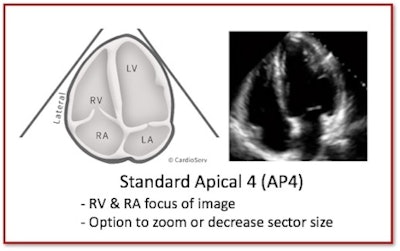
In its updated recommendations for cardiac chamber quantification, the ASE reviews two methods for measuring RA size: 2D volume measurement and linear measurements. Volume measurement is preferred, because it's more representative of the actual RA size and is a more robust and accurate method. However, linear measurements are a good alternative when you don't have full visualization to perform the RA volume.
Measuring RA volume
Right atrium volume measurement is performed from a single-plane image using either the area-length or disk-summation technique. Select which method (calculation) you will use on your ultrasound system. We personally prefer the disk-summation technique, but either method should be performed on the standard AP4 view as follows:
- End-systole at largest diameter
- Exclude tracing areas between leaflets, inferior vena cava (IVC), superior vena cava (SVC), and RA appendage
- Area length:
- Area:
- Trace the right atrium from the level of tricuspid valve annulus.
- Connect two annulus sides with a straight line across.
- Length: Length is perpendicular to annular plane.
- Area:
- Disk summation:
- Trace the right atrium from the level of tricuspid valve annulus.
- The software package will connect the two annulus sides with a straight line.
- Remember the length MUST be perpendicular to the straight line connecting the two annulus sides. This is important for accurate disk summation calculations.
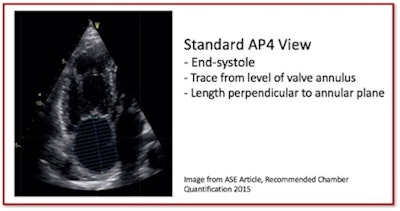
RA volume reference ranges
The updated ASE guidelines explain that a patient's sex plays a key role when determining the abnormal values of the RA size. Remember that the referenced RA volume values are sex-specific and indexed to body surface area (BSA).
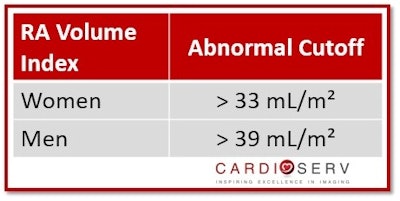
2D linear RA measurements
The heart is multidimensional structure. Research and technological advancement in ultrasound has allowed echocardiography to move from linear measurements to the preferred volumetric methods of evaluating heart structures. With that said, if you cannot fully see the RA border properly, then linear measurements are the next option. If you are unable to obtain a RA volume, the updated chamber quantification guidelines provide for two linear measurements: RA minor axis (width) and RA major axis (length).
These measurements are performed on the standard AP4 view as follows:
- End-systole at largest diameter
- RA minor axis (width):
- Distance width from lateral wall to intra-atrial septum (IAS)
- Midatrial level
- Inner edge to inner edge (I-I)
- RA major axis (length):
- Length from center of valve annulus to center of superior RA wall
- Parallel to intra-atrial septum (IAS)
- Inner edge to inner edge (I-I)
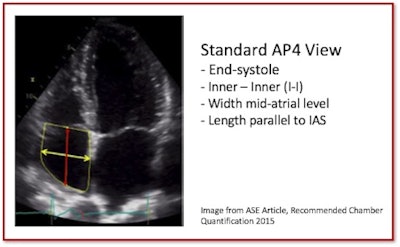
In a change from the ASE's previous guidance in 2010, the society's updated RA dimension ranges are also now sex-specific and indexed to BSA. The prior guidelines did not have enough data to provide sex-specific values and were not indexed to BSA.
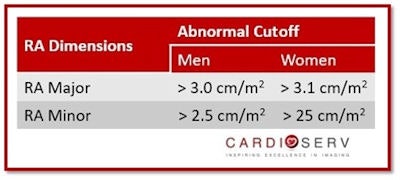
If your laboratory has older machines and/or you do not have the ability to index these linear measurements, the 2010 ASE RV guidelines for linear measurement reference values may be used as a guide. Here is an easy reference chart to go by in your scanning laboratory:
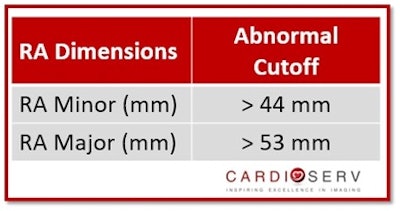
We have had success manually adding indexed volume measurements to ultrasound systems for some of our clients. We suggest that you reach out to your ultrasound vendor for help creating an indexed RA volume if this measurement is not readily available.
Cardiac cycle timing
When performing the methods to quantify the size of the RV and RA, it's important to pay attention to the correct timing of the cardiac cycle. For the RV, measure at end-diastole -- when the RV is at its widest width. When obtaining the volume for RA, it is at end-systole -- when the RA has the largest volume.
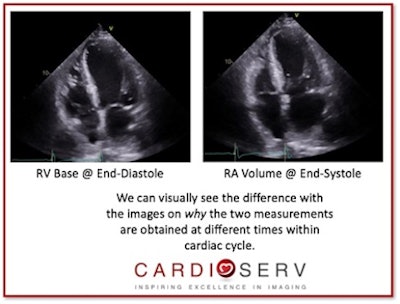
To review, here are 10 tips for correctly quantifying RA size:
 Andrea Fields, clinical cardiac director at CardioServ.
Andrea Fields, clinical cardiac director at CardioServ.- RA volume is the recommended method.
- RA measurements are indexed to BSA and sex.
- Make sure equipment is indexing volume to BSA.
- Use the standard AP4 view.
- Measure at end-systole (largest atrium diameter).
- Inner edge to inner edge (I-I).
- If you cannot see it, do not measure it!
- Use linear dimensions if you cannot trace the RA.
- The preferred method for reporting RA linear measurements is sex-specific and indexed to BSA.
- Ask your ultrasound vendor for help if you are having a hard time finding these calculations in your ultrasound system.
Our goal is for you to add right-heart quantification to your routine scanning protocol. In our next article, we'll delve into the recommend methods for quantifying RV systolic function.
Andrea Fields is the clinical cardiac director at CardioServ. Andrea can be reached by email at [email protected] or via CardioServ's website. You can also connect with her on LinkedIn.
The comments and observations expressed herein do not necessarily reflect the opinions of AuntMinnie.com, nor should they be construed as an endorsement or admonishment of any particular vendor, analyst, industry consultant, or consulting group.



















